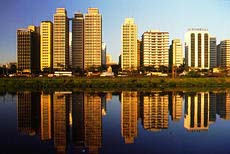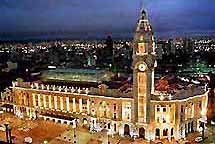Advertising by Google
São Paulo
Area: 1.523 km²
Visit map of São Paulo.
Population: 10.677.019 (est. 2003)
Weather in São Paulo.
Notice that people born in the city of São Paulo are called "paulistanos", whereas people born in the State of São Paulo are called "paulistas".
The name São Paulo is the Portuguese for Saint Paul. The city was founded by Jesuits on January 25th 1554; January 25th is the Day of Conversion of Saint Paul.
A city with many languages and accents, different religions and cuisines. Third largest metropolis in the world, São Paulo is exciting day and night. Over 10 million inhabitants have much more than Portuguese, Black and Indian offsprings. They also have Italian, Jewish and Arabic, Japanese and Korean, and many other offsprings.
The rhythm of the machines on the industrial park dictated the slogan that paulistas incorporated and execute literally: "São Paulo can´t stop growing". Nowadays, the even more accelerated rhythm of the Stock Market, the incorporation of the newest technology in industry and services and the several surveys performed in the best Brazilian university centers state that São Paulo doesn't stop.
 São Paulo is a concrete city with more than 30 parks totalizing 15 millions of square meter green area (the Parque do Ibirapuera is often called the "beach of São Paulo"), and it also has some buildings created by human beings with creative and ability, like Museu de Arte de São Paulo - MASP (São Paulo Art Museum), Memorial da América Latina (Latin America Memorial) or the architectonic complex of city center with its buildings, bridges and viaducts.
São Paulo is a concrete city with more than 30 parks totalizing 15 millions of square meter green area (the Parque do Ibirapuera is often called the "beach of São Paulo"), and it also has some buildings created by human beings with creative and ability, like Museu de Arte de São Paulo - MASP (São Paulo Art Museum), Memorial da América Latina (Latin America Memorial) or the architectonic complex of city center with its buildings, bridges and viaducts.
Because of its importance in Brazilian economy, São Paulo has the major part of central offices from national and international companies and it's a mandatory reference to businesses. However, you'll see that São Paulo has much more than that.
Founded in 1554 by the Jesuit priests, São Paulo, by those days a small town, remained peaceful until the middle of the 19th century when it started to expand as a result of coffee-growing. From then on, opportunities began to spring up everywhere and the capital of the state of São Paulo has never stopped growing. Immigrants came from all over the world to solve the labour problem and nowadays it is estimated to be the third largest Italian city in the world, the largest Japanese city outside Japan, the third largest Lebanese city outside Lebanon, the largest Portuguese city outside Portugal and the largest Spanish city outside Spain.
 In São Paulo, the mixing of races and ethnic groups has increased with the passing of time and has had a profound effect on the city's cultural and economic life (BTW, the city of São Paulo hosts one of the largest Gay Parades in the world). As a nucleus within the Metropolitan Region of São Paulo which consists of 39 municipalities, the capital is the main economic center and the largest urban concentration in Brazil. Like all metropolises, it is facing problems that have arisen from the population density, such as pollution and heavy traffic, but it is also going through a process of economic deconcentration with the restructuring of urban services, for example, the tripling of the underground rail system by the year 2004, an indication that the quality of life offered could soon be improving.
In São Paulo, the mixing of races and ethnic groups has increased with the passing of time and has had a profound effect on the city's cultural and economic life (BTW, the city of São Paulo hosts one of the largest Gay Parades in the world). As a nucleus within the Metropolitan Region of São Paulo which consists of 39 municipalities, the capital is the main economic center and the largest urban concentration in Brazil. Like all metropolises, it is facing problems that have arisen from the population density, such as pollution and heavy traffic, but it is also going through a process of economic deconcentration with the restructuring of urban services, for example, the tripling of the underground rail system by the year 2004, an indication that the quality of life offered could soon be improving.
With an economic infrastructure that was established during the last century and a half, the city has an integrated industry, a network of services linked to the main world centres and extensive resources for information, leisure and culture. There has been a trend to consolidate its vocation as a large and modern metropolis bent towards the provision of services that rely on leading edge technology.
Hotels in São Paulo
List of selected hotels in São Paulo.
Reviewed hotels in São Paulo. Hotels in the capital and other major cities of the State.
Back to Top